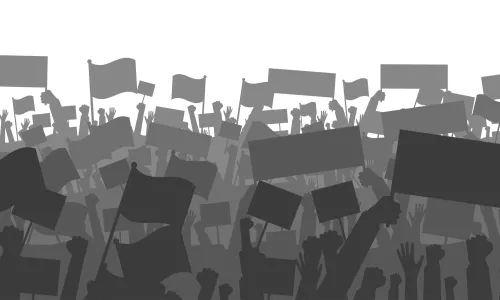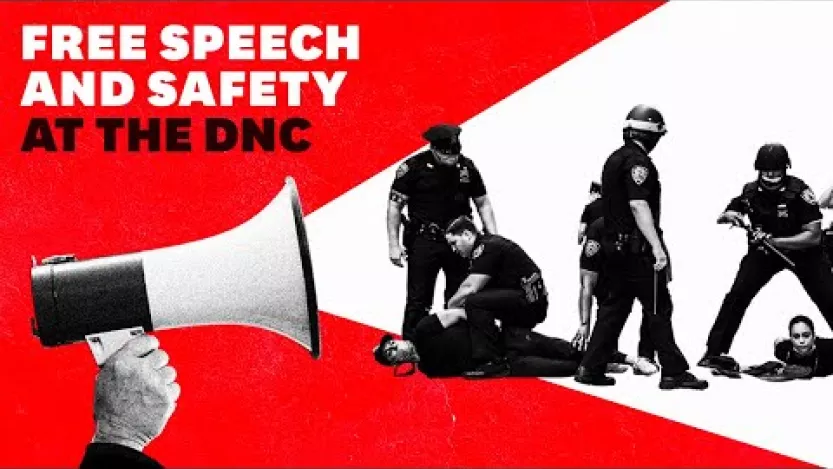Table of Contents
Protesting on public property: What you need to know
Research & Learn
Courts have repeatedly held that the First Amendment’s robust protections for free expression encompass the public’s right to protest through the constitutional protections of free speech, peaceable assembly, and petitioning the government for change.

Last updated Oct. 4, 2024.
Protests are a time-honored way for Americans to express their views and demand change. From the civil rights marches of the 1960s to more recent movements for racial justice and climate action, public protests have played a crucial role in social and political movements that have shaped our nation’s evolution.
America’s long and cherished tradition of citizens taking to streets, sidewalks, and parks to make their voices heard means public property often becomes the venue for these demonstrations. Understanding your right to protest on public property means recognizing both the broad protections afforded by the First Amendment and the narrow limitations on those protections.
Here, we’ll discuss the nature of our Constitution’s protections for the public’s right to protest on public property, the government’s ability to restrict protest under certain circumstances, and how the courts have steadfastly protected protest.
How does the First Amendment protect public protest?
The First Amendment states, “Congress shall make no law . . . abridging the freedom of speech, or of the press; or the right of the people peaceably to assemble, and to petition the Government for a redress of grievances.” The powerful language enshrining these fundamental rights ensures that Americans can express their views freely and gather in public spaces to make their voices heard.
Although the First Amendment does not explicitly mention “protest,” courts have repeatedly held that the First Amendment’s robust protections for free expression encompass the public’s right to protest through the constitutional protections of free speech, peaceable assembly, and petitioning the government for change.
The right to freedom of speech means you have the right on public property to express your opinions in many ways, including speeches, signs, and symbolic acts (like wearing protest armbands or displaying banners). The First Amendment protects a vast range of speech and expressive conduct, and courts have recognized only a few narrow and carefully defined categorical exceptions like, for example, true threats (expressing serious intent to commit an act of unlawful violence to a particular person or group) and incitement (speech directed to producing imminent lawless action that is likely to produce it).
These categorical exemptions serve as a high bar to punishment. Even with speech advocating violence, the First Amendment protects a broad spectrum of advocacy, up to and including philosophical support for violence, general endorsement of it, and even asserting the “moral propriety or even moral necessity” for violence in a given circumstance. Likewise, speech that some may find hateful, offensive, or insulting, without more, is also protected.
The right to peaceable assembly means the right to gather in groups to express your views through expressive, non-violent conduct such as marches, rallies, or demonstrations.
The right to petition the government means individuals cannot be prevented from requesting that the government address and correct specific wrongs or injustices.

Where is protest protected?
How much free speech protection a protest (or other speech) receives depends in part on its location. A protest at a public park will (and should) be treated differently than a protest inside a public library or a public college’s administrative building. When it comes to government property, courts examine what type of “forum” a location is.
Sidewalks and parks are examples of traditional public forums. The Supreme Court has recognized that such spaces have been used “immemorially” as areas for public expression. So, for instance, even a new public park is a traditional public forum, because public parks historically are havens for free expression. In traditional public forums, the government’s authority to regulate speech is “sharply circumscribed,” according to the Court. But that doesn’t mean that anything goes. The government can still put in place narrow restrictions we’ll cover below, but generally speaking, the public retains very strong free speech rights, including the right to peaceful protest, in traditional public forums.
Sometimes the government opens up areas for general public expression even though they are not traditionally associated with free expression. These areas are designated public forums. Designated public forums have the same First Amendment protections as traditional public forums. The main difference is that the government can decide to close these spaces as public forums. Unless it does so, though, the First Amendment provides the same strong protections for free expression enjoyed in traditional public forums.
If you plan to protest in an unconventional way, it is always best to check the law ahead of time to ensure you will not accidentally violate the law.
There are also limited public forums, which the government has opened up for a particular purpose rather than general expression. In limited public forums, the public still has significant First Amendment protection, but the government also has more authority than it does in traditional or designated public forums. Specifically, the government can limit expression in a limited public forum to particular groups or topics. For example, a school might allow student groups to reserve rooms for meetings but not allow members of the general public to do so. Or, a town council might allow public comments related to council business or town policies but not to other topics over which the town council exercises no control. However, as in other forums, the government cannot engage in viewpoint discrimination, which is when it attempts to regulate what opinions speakers can express. The First Amendment protects protest in a limited public forum if the protester is in the class of people for whom the forum exists and the focus of the protest is within the topics for which the forum is open.
Finally, there are nonpublic forums — public property that has not by tradition or designation been opened for public expression. Examples are polling places, military bases, and airport terminals. Even in these locations, the government does not have carte blanche to restrict speech. Any restrictions must be reasonable and viewpoint-neutral. The government could, for example, prohibit a large rally in an airport terminal, but it couldn’t ban a traveler from wearing an “I Can’t Breathe” shirt to protest police brutality.
As for private property, outside of the few narrow categories of unprotected speech, the government lacks authority to restrict your speech when it takes place on your own property. But you generally have no First Amendment right to protest on someone else’s private property without their consent.

What can the government do to regulate protest?
Even in a traditional public forum, there are still regulations the government can put in place. The most notable of these are “time, place, and manner” restrictions. These restrictions are valid provided they are justified without reference to the speech’s content, narrowly tailored to serve a significant government interest like traffic safety or residential privacy, and leave open ample alternative channels for communication. For example, the government can restrict people from protesting with a bullhorn in a residential neighborhood at 2:00 AM.
For certain large protests, such as those requiring street closures or those over a certain size in a public park, the government can require notification or even permits. Any notice or permit requirements need to be connected to the government’s actual needs and be based on clear, objective, content-neutral standards. Many courts have held that applying a notice or permit requirement to individuals or small groups is unconstitutional in traditional public forums. Courts have not set a bright-line rule distinguishing between large and small groups, so if you’re planning a protest in advance, it’s a good idea to check if there are any requirements for where you’re planning to protest. The notice period also cannot be excessively long and must allow for spontaneous protest in response to contemporaneous news and events.
With protest regulation (at least outside a limited public forum), the golden rule is that the government’s regulations must be viewpoint- and content-neutral. This means that the government cannot treat protests differently based on what they are protesting. If the government has a habit of allowing 2:00 AM protests, it cannot suddenly block a 2:00 AM protest it dislikes. Permission to protest cannot in any way be conditioned on a protest’s message.

College Protests and the First Amendment
Issue Pages
What are your free speech rights when there is a college protest on campus? FIRE explains your civil liberties on campus during times of protest.
The government also cannot use the expected reaction of other people as a justification for restricting a protest. One way this comes up is when governments require protesters to have insurance or pay other fees. Whatever financial burdens the government places on a protest, they must reflect actual costs and risks based on factors like crowd size that aren’t related to the protest’s message. The government cannot impose an additional burden on a “controversial” protest out of fear other people will react negatively to it.
Finally, the government can enforce laws against crimes like vandalism and violence, even if those crimes happen as part of an expressive activity, such as fighting with counter-protesters or spray-painting a political slogan on a wall. These activities can be punished not because of the message they send, but because the way they send the message is itself a crime that would be punishable even if it had nothing to do with expression. So, for example, while Americans have the constitutional right to burn the U.S. flag, that right does not mean that an individual may burn a flag in a place where setting anything on fire is prohibited. Likewise, protesters may burn flags that belong to them, but taking down someone else’s flag and burning it may be theft and/or destruction of property.
If you plan to protest in an unconventional way, it is always best to check the law ahead of time to ensure you will not accidentally violate the law.